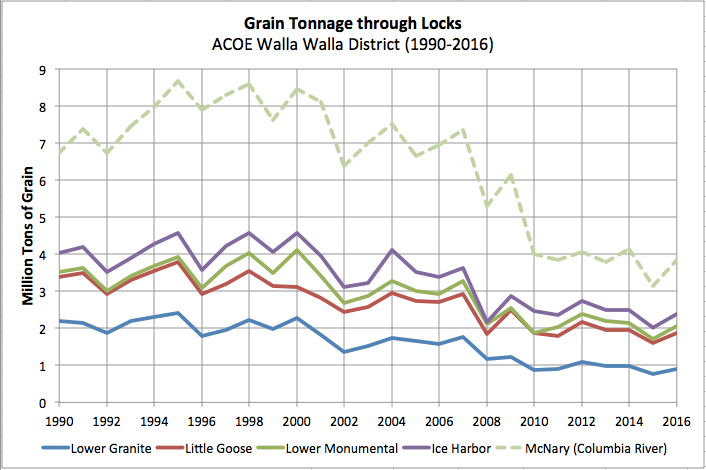 Can rail save salmon? In a detailed report, Solutionary Rail (solutionaryrail.org/) presents the steps needed for rail transportation in southeastern Washington and north-central Idaho to replace shipping grain by barge on the lower Snake River. According to Solutionary Rail, this modal shift would benefit the state of Washington, Pacific Northwest tribes, the environment, rural communities, wheat farmers and Snake River salmon.
Can rail save salmon? In a detailed report, Solutionary Rail (solutionaryrail.org/) presents the steps needed for rail transportation in southeastern Washington and north-central Idaho to replace shipping grain by barge on the lower Snake River. According to Solutionary Rail, this modal shift would benefit the state of Washington, Pacific Northwest tribes, the environment, rural communities, wheat farmers and Snake River salmon.
Snake River barge transportation faces growing uncertainties:
- Threatened and endangered Snake River salmon are on a path to extinction; Pacific Northwest fish scientists and federal agencies agree the best, and likely the only, way to recover these fish is to breach the four lower Snake River dams.
- Snake River water temperatures frequently exceed what salmon need to survive and can kill tens of thousands of migrating fish; the only identified solution is the elimination of solar-heated reservoirs behind the lower Snake dams.
- Since the year 2000, freight volume on the lower Snake has steadily declined. For example, all container-on-barge shipping has ceased with garbanzo, lentil and dry pea farmers now shipping their product by rail; the number of loaded barges passing through Lower Granite dam near the head of navigation has declined by 70%.
- The lower Snake River navigation system is aging, requiring more frequent and expensive repairs; the taxpayer subsidy now exceeds $40,000 per barge.
- Continuing litigation can leave decision-making up to the courts, adding still more uncertainty.
Can rail save salmon? You'll find a comprehensive answer at SolutionaryRail.org/lsrbarge2rail or Google "solutionary rail snake river."
Related Pages:
Can Trains Save Salmon? by Bill Moyer, Spokesman-Review, 10/29/22
Linwood Laughy, Moscow
Saving Salmon
Moscow-Pullman Daily News, November 8, 2022
See what you can learn
learn more on topics covered in the film
see the video
read the script
learn the songs
discussion forum



 Can rail save salmon? In a detailed report, Solutionary Rail (solutionaryrail.org/) presents the steps needed for rail transportation in southeastern Washington and north-central Idaho to replace shipping grain by barge on the lower Snake River. According to Solutionary Rail, this modal shift would benefit the state of Washington, Pacific Northwest tribes, the environment, rural communities, wheat farmers and Snake River salmon.
Can rail save salmon? In a detailed report, Solutionary Rail (solutionaryrail.org/) presents the steps needed for rail transportation in southeastern Washington and north-central Idaho to replace shipping grain by barge on the lower Snake River. According to Solutionary Rail, this modal shift would benefit the state of Washington, Pacific Northwest tribes, the environment, rural communities, wheat farmers and Snake River salmon.
